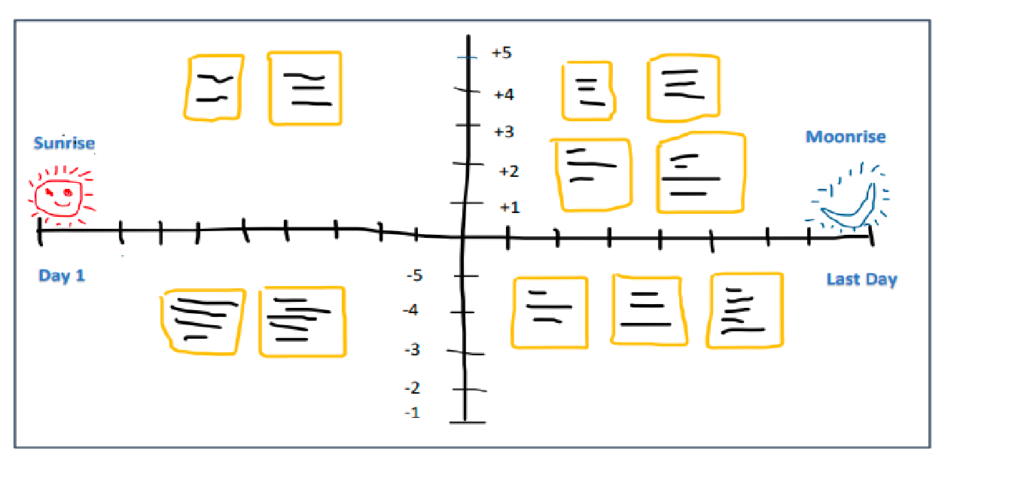
How to make your retrospective ceremony effective
In this blog, we attempt to answer the below key questions related to the retrospective ceremony, the
benefits of which still eludes many team members in an Agile setting.
What is a Retrospective Ceremony?
Who participates in this ceremony?
What are some of the anti-patterns of a retrospective? and its
adverse impacts on the team
What’s the purpose and value of conducting a retrospective?
How you can make your retrospective ceremony effective?
What are the key takeaways from a retrospective? And
conclusion
What is a Retrospective Ceremony?
An Agile team conducts the Retrospective ceremony at the end of the current sprint and before the
start of the next sprint or an iteration. Usually, it happens after the sprint review ceremony.
Who participates in this ceremony?
All team members of a scrum team participate in this ceremony. This is an opportunity for the teams
to engage in continuous improvement by looking at what worked well in the last sprint, what didn’t
work well and what are some of the areas that are still a puzzle for the team.
However, we have seen that many team members are not so enthusiastic about conducting this key
ceremony, or they do it half-heartedly. Maybe they really didn’t know or appreciate the value of this
ceremony that can help the team uncover potential obstacles and also work on areas of improvement.
In this blog, I’ll try to highlight the significance of this key ceremony, and how it can be done in a very
an effective way so that every team member enjoys participating in it, and they are willing to act upon
the areas of improvement in a progressive manner.
So, let’s Begin.
Making your Retrospective Ceremony Effective for Your Agile Team
As defined by the Scrum Guide (Authored and maintained by the Scrum founders – Ken Schwaber and
Jeff Sutherland), the purpose of the sprint retrospective is to:
Inspect how did the last sprint go – in terms of sprint goals achieved, quality, processes,
people, and so on.
Identify what went well and what really did not go well and mark areas for improvements
(typically top-2 or top-3 areas for improvement)
Come up with Action Plan for improvements
However, it’s not clear whether everyone on the team clearly has read the Scrum Guide and also if
they really understand the significance of retrospectives. Actually, it’s not about the teams not knowing
what a Retrospective is all about; it’s more to do with the lack of energy and creativity in conducting
a Retrospective. It’s simply because the teams know it’s a mundane routine tedious activity with no
fun or learning. Therefore, it’s imperative for the team’s Scrum Master or the Iteration Manager to
bring the zing into the retrospective and make it a more engaging and enlightening experience for all.
So, in this type of setting where teams really do not look forward to joining a Retrospective, it
becomes important for the scrum master and IM to evaluate what challenges lies ahead of doing a
retrospective and address the same.
First of all, the benefits of having a retrospective must be known to all. Some of them are namely:
• A golden opportunity for the team members to express their thoughts and opinion freely and
without any fear or reprimand
• Key Stakeholders, Scrum Master, and IMs – they must listen to what team members are
saying.
• A well-conducted retrospective shows how motivated the team is, whether they are self-organized and self-managed, and sufficiently empowered.
• How well the team members are collaborating with each other, and whether there is a Team
Level Accountability, and whether they are able to solve most of the problems by themselves.
Also, to be noted, if no actions have been taken from the past retrospectives, team members will be
less motivated to bring up new issues or concerns. They will feel power-less and less inclined,
especially in large projects where the issues get caught up in inter-dependencies between various
entities.
Now, having seen some of the reasons for not being able to have a truly effective retrospective, let’s take a step back to see whether we truly understand the value of doing a retrospective in the first place.
From my experience as a Scrum Master and also as a Development Manager, I have discovered that
many Agile Leaders, including myself, in the beginning, did not truly grasp the true value of doing a
retrospective. It could be partly due to ignorance, or not having appropriate tools and templates for
doing so.
In the early day, teams would collaborate on an MS Excel or a Word document where they will capture
the key learnings, but then it will be long forgotten, and it will be cumbersome to maintain it, let alone
do something about it. Well, it’s no one’s fault. Over time, new collaborative tools and templates have
emerged that have helped facilitate and conduct retrospectives effectively.
One must not forget the retrospective ceremony is a great opportunity to recognize and appreciate
everyone’s contribution. People feel happy and motivated when their work is appreciated in a public
forum like a retrospective. Besides this, it’s also a great place to uncover what puzzles people, what
they really want to improve, and how they can address common risks better as a team.
In recent times, there have been many templates and methods proposed for making your retrospective
very engaging, fruitful and truly exciting, and fun at the same time. People really look forward to joining
this ceremony soon after the sprint review and are willing to share their input.
What are some of the anti-patterns of a retrospective? and its
adverse impacts on the team
Here in this blog, I am going to talk about a template that I have widely used and it’s been liked by
many team members. They have found it quite useful, very engaging, and inspiring.
This is a simple template, where you’ll see two axes intersecting each other at a center point.
The X-Axis is the timeline of a given sprint – from the First day, what is called Sunrise, to the last
day of the sprint, which is called Moonrise.

Making your Retrospective ceremony effective for your Agile Teams
Next, the team members will post the stickies along the axes in the following manner:
Based on a particular event or any point of observation, when did it occur during the sprint. So, the
sticky will be posted on a particular tick-mark indicating when it occurred.
Based on whether it’s a sticky replated to What’s Working Well, then the team member will stick it on
the Y-axis above the centerline.
If the sticky is about What didn’t Go Well, then it will be stuck on the Y-Axis below the centerline, as
in the picture below:

Thereafter, once every team member has pated his/her sticky on the appropriate axis, then the SM
or the team’s IM will facilitate voting and grouping of the related items.
For e.g., if many team members have identified a common item – say the test server was not
available for testing and it had impacted delivering the user stories, then the related stickies will be
grouped together.
Once the related stickies have been grouped together then they will be identified into various
categories. For e.g., there could be related stickies on Infrastructure, then there could be related
stickies for Bad Requirements, or let’s say something related to key team members on Unplanned
leaves.
Once all the related stickies are organized in their respective category, then the team will brainstorm
on what top-2 or top-3 categories to address as part of the action plan for improvement. It’s up to
the team to determine which are those categories, which if not resolved or addressed can become
bigger problems for the team in the future.
Some interesting aspects of this template and why team members really like it over other templates:
• They can clearly identify when during the sprint a particular issue cropped up and what was
the impact of it on the sprint goals
• They can see that there are related points identified by their fellow team members
• Agreement and consensus emerge on common areas of pain as well as success
• Team members share freely and express their opinion without any fear or hesitation
• The issues reported are kept neutral
• The language used to describe issues is objective and is not about any individual
• There’s no personal ax to grind, it’s all about teamwork and collaboration
• Team members find it fun and engaging and they fully participate
Over a period of time, team members appreciate the value of retrospectives and can see continuous
improvement. At the next retrospective teams first look at action items for the previous
retrospective and provide a brief summary of actions taken and progress made on resolving some of
the outstanding issues. This is usually recorded in a separate section on the template – and action
items that are completed are struck off – so that it’s visible to everyone and next time those action
items are not discussed or reviewed.
Conclusion:
Sprint Retrospective, if done effectively, can motivate and energize your teams, by giving them
an opportunity to express themselves and speak up about positive as well as negative things
objectively. They also feel happy and excited about sharing their ideas and being heard by everyone.
In fact, every team member is encouraged to speak up and share his/her ideas, thoughts, and
concerns. This helps build a greater bond and understanding amongst every team member.
Thank you all for reading this Blog. We at AgileWaters wish and hope that you’d have found this
article interesting and that you’ll find key takeaways from it and adapt it at your workplace, and
realize the benefits for your wonderful team.
Wish You Good Luck
Author :
Comments are closed.









Nice article on making retrospective more engaging. Thanks Hiren!